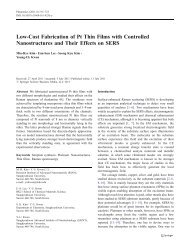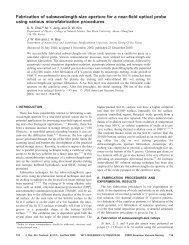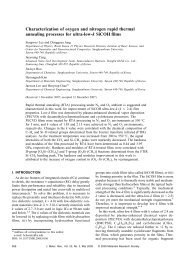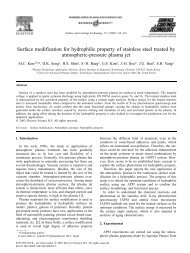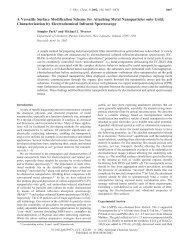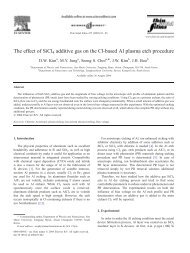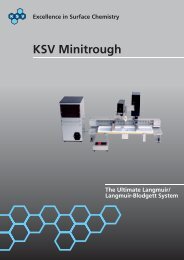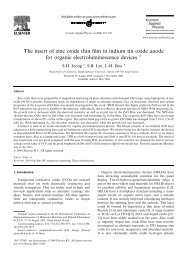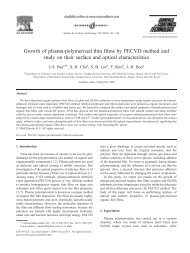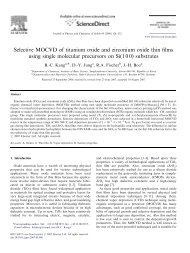Investigation of the p-GaN Ohmic Contact Property by Using a ...
Investigation of the p-GaN Ohmic Contact Property by Using a ...
Investigation of the p-GaN Ohmic Contact Property by Using a ...
- No tags were found...
You also want an ePaper? Increase the reach of your titles
YUMPU automatically turns print PDFs into web optimized ePapers that Google loves.
<strong>Investigation</strong> <strong>of</strong> <strong>the</strong> p-<strong>GaN</strong> <strong>Ohmic</strong> <strong>Contact</strong> <strong>Property</strong> <strong>by</strong>· · · – T. H. Kim et al. -1895-gated <strong>the</strong> <strong>Ohmic</strong> property <strong>of</strong> a Ni(10 nm)/ITO(250 nm)bilayer system [9]. The as-prepared electrode showedSchottky characteristics; on <strong>the</strong> o<strong>the</strong>r hand, <strong>the</strong> rapid<strong>the</strong>rmal processed one revealed a low resistance <strong>of</strong> 8.6 ×10 −4 ohm·cm 2 at a temperature <strong>of</strong> 600 ◦ C in an air atmosphere.It was suggested that <strong>the</strong> contact resistancewas lowered <strong>by</strong> an increase in <strong>the</strong> <strong>of</strong> hole carrier concentration,and that a p-type semiconductor NiO had beenformed at <strong>the</strong> interface.However, <strong>the</strong> external efficiency declines <strong>by</strong> less than50 % transmittance <strong>of</strong> <strong>the</strong> metal electrode in <strong>the</strong> visibleregion in spite <strong>of</strong> its having a good electrical property.Among <strong>the</strong> transparent conductive oxides, suchas indium tin oxide (ITO), aluminum-doped zinc oxide(AZO), indium zinc oxide (IZO) and cadmium tin oxide(CTO), ITO is a good candidate material to replace <strong>the</strong>semi-transparent metal electrode, because <strong>the</strong> transmittanceis more than 95 % and because it has good electricalproperties, such as low resistance (5 × 10 −4 ◦ C), highcarrier concentration (10 20 ∼ 10 21 /cm 3 ) and mobility (20∼ 25 cm 2 /V·S) [10–12]. The light extraction efficiency isexpected to increase to more than 10 % if <strong>the</strong> metal electrodeis used for ITO. When <strong>the</strong> ITO is directly depositedon <strong>the</strong> p-<strong>GaN</strong> semiconductor, <strong>the</strong> electrical property isnon-<strong>Ohmic</strong>. Therefore, a new process development isneeded to optimize <strong>the</strong> <strong>Ohmic</strong> contact property. Changet al. reported that a thin In 0.1 Ga 0.9 N layer insertedinto <strong>the</strong> ITO/p-<strong>GaN</strong> interface reduced <strong>the</strong> Schottky barrierheight [13]. The contact resistance was 4.5 × 10 −2ohm·cm 2 after annealing at a temperature <strong>of</strong> 500 ◦ C ina N 2 environment. They suggested that Ga-vacanciescreated <strong>by</strong> out-diffusion <strong>of</strong> gallium atoms played an importantrole in <strong>the</strong> <strong>Ohmic</strong> mechanism. Kuo et al. reportedthat <strong>the</strong> low resistance (1.2 × 10 −3 ohm·cm 2 )and a high transmittance (86.5 %) had been attained <strong>by</strong>inserting a Si-doped n + In<strong>GaN</strong>/<strong>GaN</strong> short-period superlattice(SPS) layer [14]. This layer was functioned as atunneling layer.According to <strong>the</strong> previous results, <strong>the</strong>re is a tendencyto adopt a high-transmittance electrode like ITO ra<strong>the</strong>rthan a semi-transparent metal electrode, although metalelectrode shows better electrical properties than ITOdoes. However, few works in <strong>the</strong> literature have addressedcurrently available processes and <strong>the</strong> mechanism<strong>of</strong> <strong>Ohmic</strong> contact, although many studies have been performedto improve <strong>the</strong> ITO/p-<strong>GaN</strong> <strong>Ohmic</strong> characteristics[15, 16]. In this study, we report optimized resultsfor <strong>the</strong> <strong>Ohmic</strong> properties <strong>by</strong> inserting a charge transportenhanced layer (CTEL), on n + In<strong>GaN</strong>/<strong>GaN</strong> superlattice.We also suggest <strong>the</strong> <strong>Ohmic</strong> mechanism between<strong>the</strong> p-<strong>GaN</strong>/CTEL and <strong>the</strong> ITO layer <strong>by</strong> using a surfaceanalysis and a synchrotron radiation analysis.II. EXPERIMENTThe epitaxial layer <strong>of</strong> <strong>the</strong> LED structure was grownon a sapphire substrate <strong>the</strong> using metal-organic chemicalvapor deposition (MOCVD). The LED structure is asfollows: a <strong>GaN</strong> nucleation layer deposited at 520 ◦ C, a 3µm-thick Si-doped <strong>GaN</strong> layer, a five period In<strong>GaN</strong>/<strong>GaN</strong>multiple quantum well (MQW), and a 0.15 µm-thick Mgdoped <strong>GaN</strong> layer. The Mg doping concentration <strong>of</strong> p-<strong>GaN</strong> was 1.2 × 10 20 /cm 3 . The charge transfer enhancedlayer (CTEL) deposited on p-<strong>GaN</strong> was a Si-doped In-<strong>GaN</strong>/<strong>GaN</strong> superlattice with a <strong>the</strong> because <strong>of</strong> several nm.The ITO electrode was deposited <strong>by</strong> using <strong>the</strong> R.F.-magnetron sputtering method and had a thickness <strong>of</strong>300 nm. The electrical properties were measured at variousannealing conditions for <strong>the</strong> ITO(30 nm)/CTEL(n +In<strong>GaN</strong>/<strong>GaN</strong>)/p − <strong>GaN</strong> sample. The operation voltages(Vop) were measured at 20 mA with a 375 × 330 µm 2lateral structure LED. The contact resistances were calculatedusing <strong>the</strong> circular-TLM method.ITO samples <strong>of</strong> 5 nm in thickness were specially designedto study <strong>the</strong> chemistry <strong>of</strong> interface reaction becauseit is impossible to investigate non-destructively <strong>the</strong>interface <strong>by</strong> inserting a CTEL overlayer as thick as 300nm. These samples were annealed at temperatures <strong>of</strong>(400 ◦ C, 650 ◦ C, and 800 ◦ C) in (pure N 2 , 0.1 % O 2 /N 2 ,0.2 % O 2 /N 2 , and 0.5 % O 2 /N 2 ). Surface and interfaceanalyses for <strong>the</strong> annealed samples were performed usingX-ray photoelectron spectroscopy (XPS), time-<strong>of</strong>-flightsecondary ion mass spectrometry (TOF-SIMS), scanningelectron microscopy (SEM), and atomic force microscopy(AFM). Near-edge X-ray absorption spectroscopy (NEX-AFS) was also utilized to analyze <strong>the</strong> chemical speciesnewly formed at <strong>the</strong> interface. The NEXAFS experimentwas conducted at <strong>the</strong> 8A1(U7) beam line in <strong>the</strong>Pohang Accelerator Laboratory (PAL). The spectra wereobtained <strong>by</strong> recording <strong>the</strong> sample current in total electronyield (TEY) mode as a function <strong>of</strong> energy. Theabsolute photon energy scale was referenced to <strong>the</strong> value<strong>of</strong> 401.10 eV, which position is <strong>the</strong> second π ∗ resonancepeak for gas phase N 2 .III. RESULTS AND DISCUSSIONFigure 1 shows <strong>the</strong> operation voltages (Vop) and contactresistances at a temperature <strong>of</strong> 650 ◦ C for variousambient conditions (pure N 2 , 0.1 % O 2 /N 2 , 0.2 % O 2 /N 2 ,and 0.5 % O 2 /N 2 ). The operation voltage (Vop) and <strong>the</strong>contact resistance are 3.38 V and 4 × 10 −2 ohm·cm 2 , respectively,for pure N 2 , reach <strong>the</strong>ir lowest values <strong>of</strong> 3.27V and 1.43 × 10 −3 ohm·cm 2 at a 0.1 % O 2 /N 2 ratio,and finally rise again to 3.53 V and 3.1 × 10 −1 ohm·cm 2with increasing rate <strong>of</strong> O 2 /N 2 ratio. It is noted that <strong>the</strong>addition <strong>of</strong> O 2 is undoubtedly required to achieve <strong>the</strong>optimum <strong>Ohmic</strong> condition during <strong>the</strong> annealing process;however, a large amount <strong>of</strong> O 2 can bring about a badeffect.Figure 2 shows <strong>the</strong> high-resolution N K-edge NEXAFSspectra for various conditions. As mentioned above, <strong>the</strong>NEXAFS technique is able to examine <strong>the</strong> interface reactionnon-destructively, unlike XPS, SIMS, and AES



